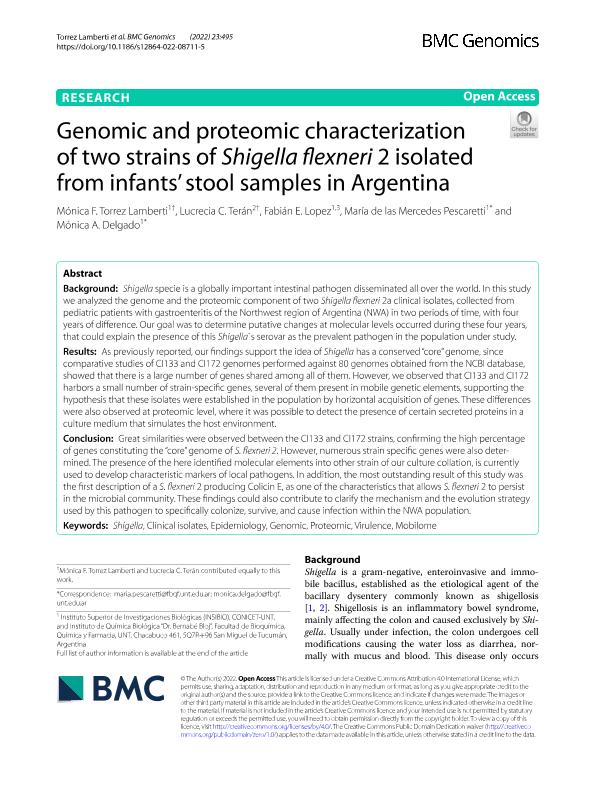Mostrar el registro sencillo del ítem
dc.contributor.author
Torrez Lamberti, Monica Florencia

dc.contributor.author
Teran, Lucrecia Cecilia

dc.contributor.author
Lopez, Fabian Enrique

dc.contributor.author
Pescaretti, María de Las Mercedes

dc.contributor.author
Delgado, Monica Alejandra

dc.date.available
2023-11-02T15:31:40Z
dc.date.issued
2022-06
dc.identifier.citation
Torrez Lamberti, Monica Florencia; Teran, Lucrecia Cecilia; Lopez, Fabian Enrique; Pescaretti, María de Las Mercedes; Delgado, Monica Alejandra; Genomic and proteomic characterization of two strains of Shigella flexneri 2 isolated from infants’ stool samples in Argentina; BioMed Central; BMC Genomics; 23; 1; 6-2022; 1-26
dc.identifier.issn
1471-2164
dc.identifier.uri
http://hdl.handle.net/11336/216870
dc.description.abstract
Background: Shigella specie is a globally important intestinal pathogen disseminated all over the world. In this study we analyzed the genome and the proteomic component of two Shigella flexneri 2a clinical isolates, collected from pediatric patients with gastroenteritis of the Northwest region of Argentina (NWA) in two periods of time, with four years of difference. Our goal was to determine putative changes at molecular levels occurred during these four years, that could explain the presence of this Shigella`s serovar as the prevalent pathogen in the population under study. Results: As previously reported, our findings support the idea of Shigella has a conserved “core” genome, since comparative studies of CI133 and CI172 genomes performed against 80 genomes obtained from the NCBI database, showed that there is a large number of genes shared among all of them. However, we observed that CI133 and CI172 harbors a small number of strain-specific genes, several of them present in mobile genetic elements, supporting the hypothesis that these isolates were established in the population by horizontal acquisition of genes. These differences were also observed at proteomic level, where it was possible to detect the presence of certain secreted proteins in a culture medium that simulates the host environment. Conclusion: Great similarities were observed between the CI133 and CI172 strains, confirming the high percentage of genes constituting the “core” genome of S. flexneri 2. However, numerous strain specific genes were also determined. The presence of the here identified molecular elements into other strain of our culture collation, is currently used to develop characteristic markers of local pathogens. In addition, the most outstanding result of this study was the first description of a S. flexneri 2 producing Colicin E, as one of the characteristics that allows S. flexneri 2 to persist in the microbial community. These findings could also contribute to clarify the mechanism and the evolution strategy used by this pathogen to specifically colonize, survive, and cause infection within the NWA population.
dc.format
application/pdf
dc.language.iso
eng
dc.publisher
BioMed Central

dc.rights
info:eu-repo/semantics/openAccess
dc.rights.uri
https://creativecommons.org/licenses/by/2.5/ar/
dc.subject
CLINICAL ISOLATES
dc.subject
EPIDEMIOLOGY
dc.subject
GENOMIC
dc.subject
MOBILOME
dc.subject
PROTEOMIC
dc.subject
SHIGELLA
dc.subject
VIRULENCE
dc.subject.classification
Bioquímica y Biología Molecular

dc.subject.classification
Ciencias Biológicas

dc.subject.classification
CIENCIAS NATURALES Y EXACTAS

dc.title
Genomic and proteomic characterization of two strains of Shigella flexneri 2 isolated from infants’ stool samples in Argentina
dc.type
info:eu-repo/semantics/article
dc.type
info:ar-repo/semantics/artículo
dc.type
info:eu-repo/semantics/publishedVersion
dc.date.updated
2023-11-01T11:10:02Z
dc.journal.volume
23
dc.journal.number
1
dc.journal.pagination
1-26
dc.journal.pais
Reino Unido

dc.journal.ciudad
Londres
dc.description.fil
Fil: Torrez Lamberti, Monica Florencia. Consejo Nacional de Investigaciones Científicas y Técnicas. Centro Científico Tecnológico Conicet - Tucumán. Instituto Superior de Investigaciones Biológicas. Universidad Nacional de Tucumán. Instituto Superior de Investigaciones Biológicas; Argentina
dc.description.fil
Fil: Teran, Lucrecia Cecilia. Consejo Nacional de Investigaciones Científicas y Técnicas. Centro Científico Tecnológico Conicet - Tucumán. Centro de Referencia para Lactobacilos; Argentina
dc.description.fil
Fil: Lopez, Fabian Enrique. Consejo Nacional de Investigaciones Científicas y Técnicas. Centro Científico Tecnológico Conicet - Tucumán. Instituto Superior de Investigaciones Biológicas. Universidad Nacional de Tucumán. Instituto Superior de Investigaciones Biológicas; Argentina. Universidad Nacional de Chilecito; Argentina
dc.description.fil
Fil: Pescaretti, María de Las Mercedes. Consejo Nacional de Investigaciones Científicas y Técnicas. Centro Científico Tecnológico Conicet - Tucumán. Instituto Superior de Investigaciones Biológicas. Universidad Nacional de Tucumán. Instituto Superior de Investigaciones Biológicas; Argentina
dc.description.fil
Fil: Delgado, Monica Alejandra. Consejo Nacional de Investigaciones Científicas y Técnicas. Centro Científico Tecnológico Conicet - Tucumán. Instituto Superior de Investigaciones Biológicas. Universidad Nacional de Tucumán. Instituto Superior de Investigaciones Biológicas; Argentina
dc.journal.title
BMC Genomics

dc.relation.alternativeid
info:eu-repo/semantics/altIdentifier/doi/http://dx.doi.org/10.1186/s12864-022-08711-5
Archivos asociados
